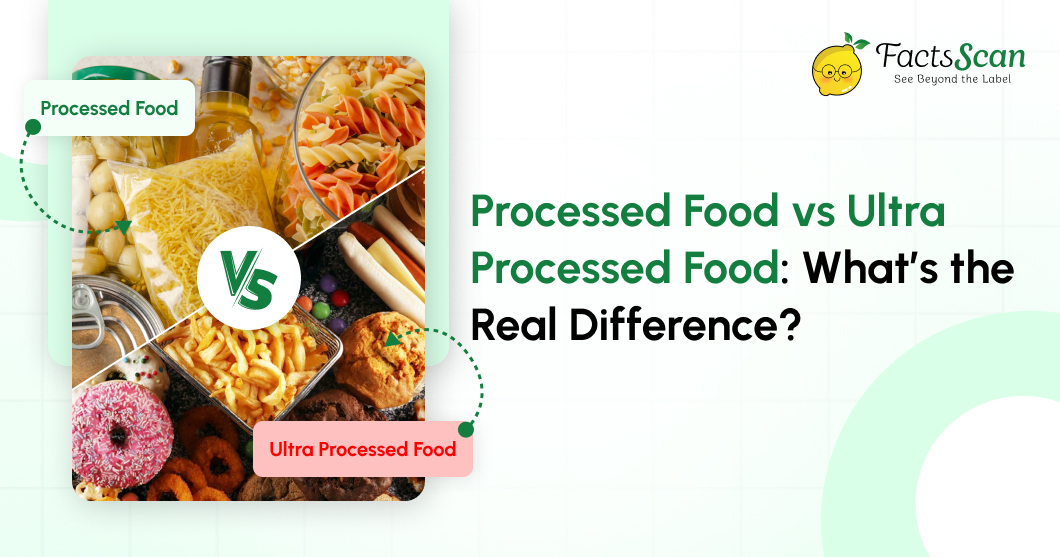Processed Food vs Ultra Processed Food: What’s the Real Difference?
Summary :
Discover the key differences between processed and ultra-processed foods and why it matters for your health. Learn how these foods are categorized, their impact on nutrition, and how informed choices can improve your well-being. Explore this essential guide to make smarter dietary decisions.
Introduction
When you walk through the aisles of any supermarket, nearly every packaged item you pick up could fall into the category of processed food. But what does that really mean? On top of that, you might hear about ultra-processed foods being singled out in health conversations. These two categories are not the same, even though they sound similar.
To make informed food choices, it’s critical to understand the distinctions between processed and ultra-processed foods, how they impact your health, and how you can minimize your reliance on the latter while still enjoying convenience. Here, we unpack the key differences, provide real-world examples, and share actionable tips for a healthier diet.
What Are Processed Foods?
Processed foods include any food item that has been altered in some way during preparation. This can involve methods like freezing, canning, drying, or adding preservatives to extend shelf life. For example, blanching vegetables and freezing them is a type of processing.
Not all processed foods are inherently unhealthy. Many, like frozen vegetables or canned beans, can be part of a balanced diet. The key is what kind of processing is involved and whether it adds or subtracts nutritional value.
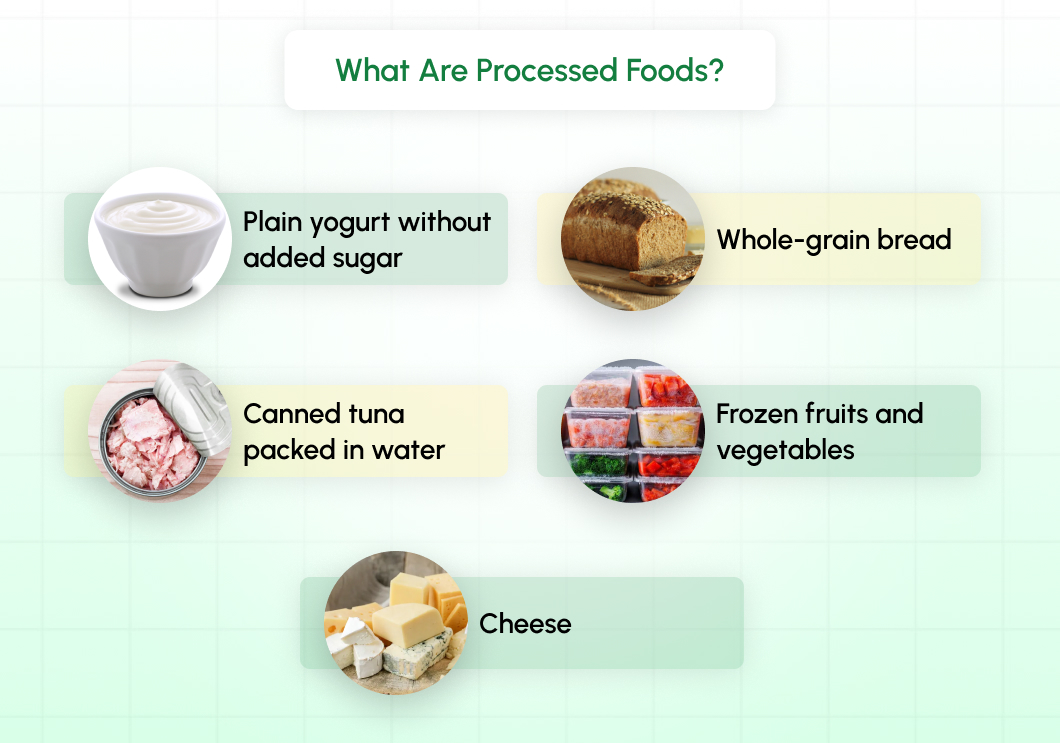
Examples of Processed Foods:
- Plain yogurt without added sugar
- Whole-grain bread
- Canned tuna packed in water
- Frozen fruits and vegetables
- Cheese
What Are Ultra-Processed Foods?
Ultra-processed foods, on the other hand, go far beyond simple processing. These are factory-made products formulated using industrial techniques and ingredients that rarely resemble anything found in home kitchens. Think artificial flavors, colorings, thickeners, and emulsifiers. Ultra-processed foods are designed to be hyper-palatable, convenient, and long-lasting, often at the cost of nutrition.
A good rule of thumb? If the ingredient list reads more like a chemistry experiment than a recipe, you’re likely dealing with an ultra-processed food.
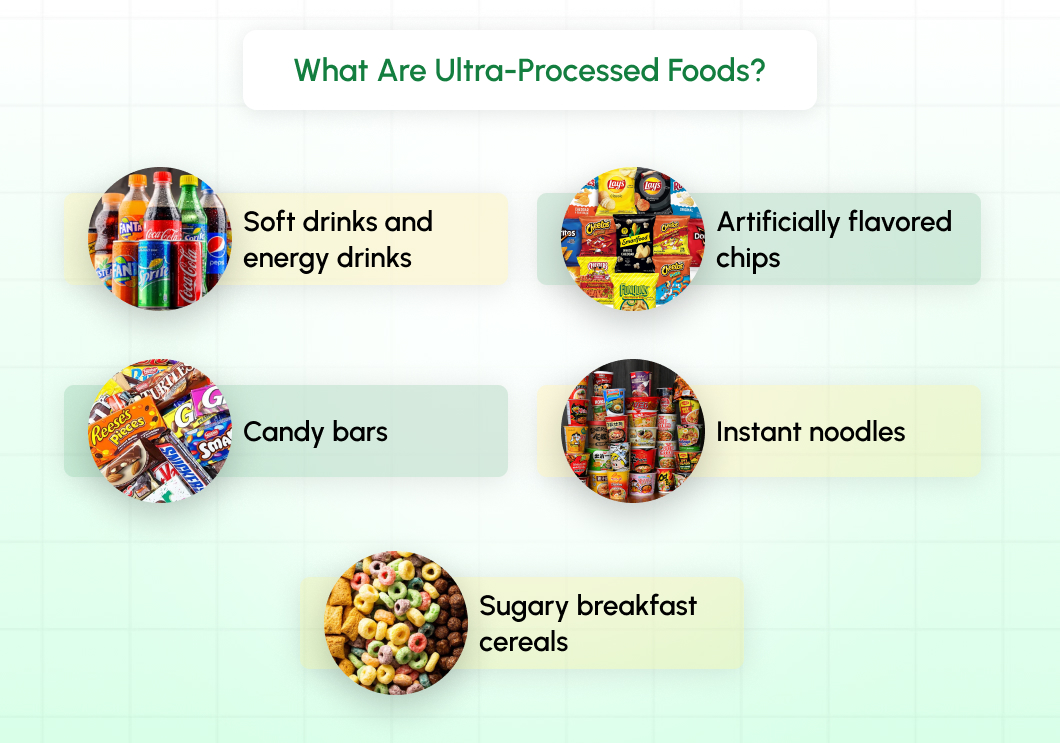
Examples of Ultra-Processed Foods:
- Soft drinks and energy drinks
- Artificially flavored chips
- Candy bars
- Instant noodles
- Sugary breakfast cereals
Key Differences Between Processed and Ultra Processed Foods
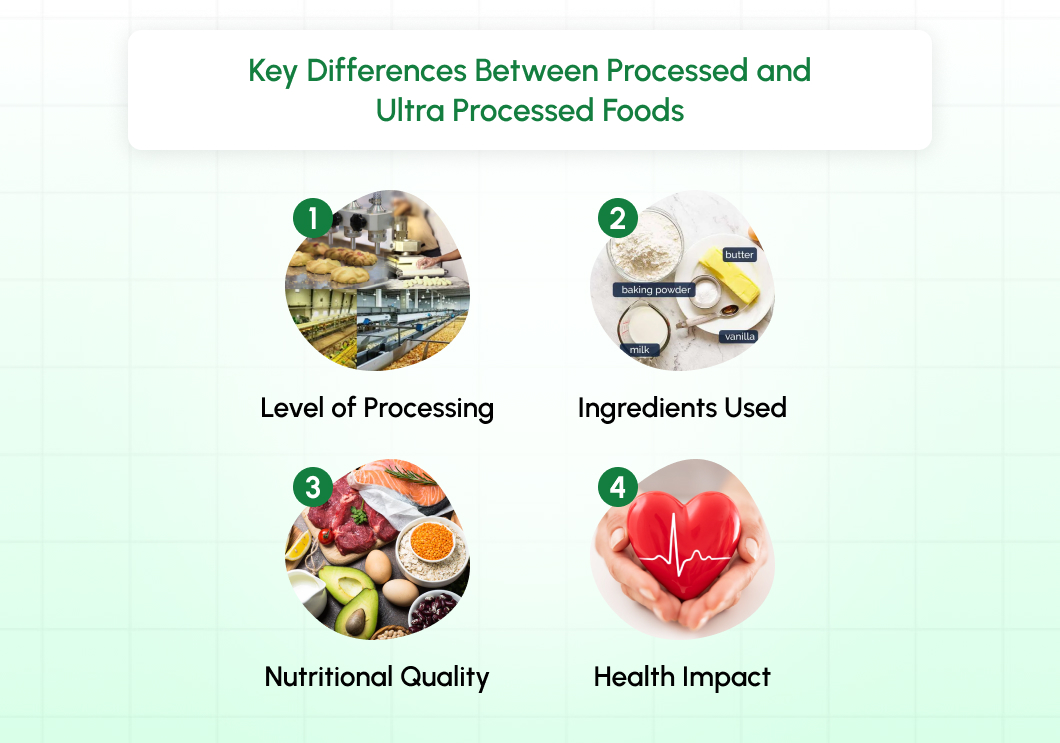
1. Level of Processing
- Processed Foods are modified through simpler, more natural methods like freezing, drying, or preserving. They retain most of their original nutrients.
- Ultra-Processed Foods undergo heavy industrial processes, resulting in products that are far removed from their natural state.
2. Ingredients Used
- Processed foods often include just a few recognizable ingredients. For example, sliced bread might include flour, yeast, and salt.
- Ultra-processed foods contain additives like high-fructose corn syrup, food dyes, and artificial preservatives. These are added to enhance taste, texture, and shelf life.
3. Nutritional Quality
- Processed foods can still provide essential nutrients. For instance, a can of black beans retains fiber and protein.
- Ultra-processed foods are often high in calories, added sugar, unhealthy fats, and sodium, but low in fiber, vitamins, and minerals.
4. Health Impact
- Processed foods, when chosen wisely, can contribute to a healthy diet.
- Ultra-processed foods are linked to various health risks, including obesity, diabetes, and heart disease, due to their poor nutritional profile and high level of artificial additives.
The Impact of Ultra-Processed Foods on Health
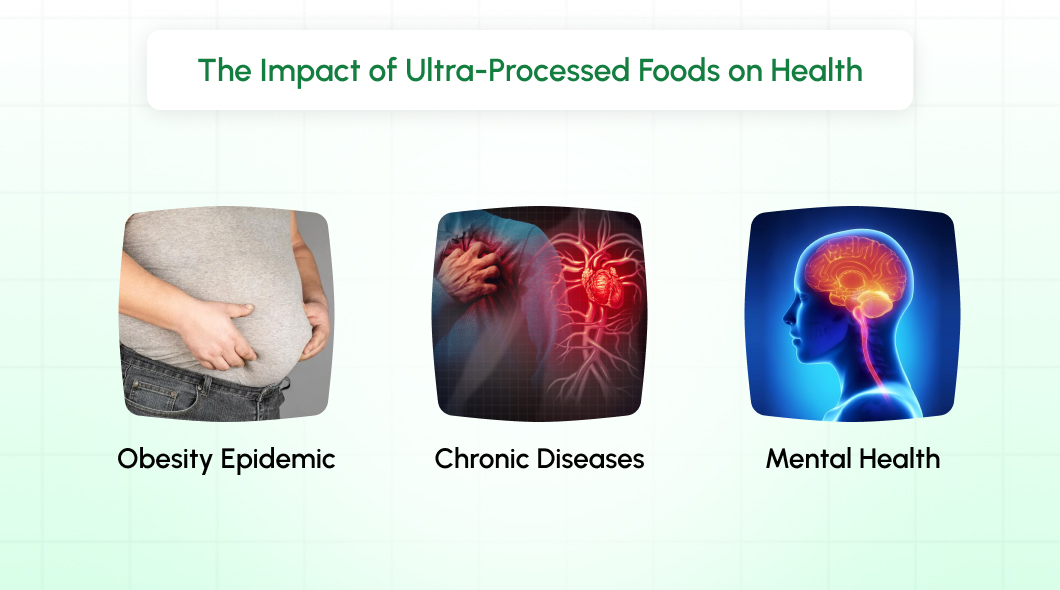
1. Obesity Epidemic
Ultra-processed foods are designed to be addictive. The high sugar, fat, and sodium content, combined with artificial flavors, can lead to overeating. Studies show a direct link between regular consumption of ultra-processed foods and weight gain.
2. Chronic Diseases
Diets rich in ultra-processed foods have been associated with a higher risk of developing conditions like type 2 diabetes, hypertension, and cardiovascular disease.
3. Mental Health
Emerging evidence suggests a connection between ultra-processed food consumption and mental health issues. These foods may contribute to inflammation, which has been linked to depression and anxiety.
How to Identify Ultra-Processed Foods
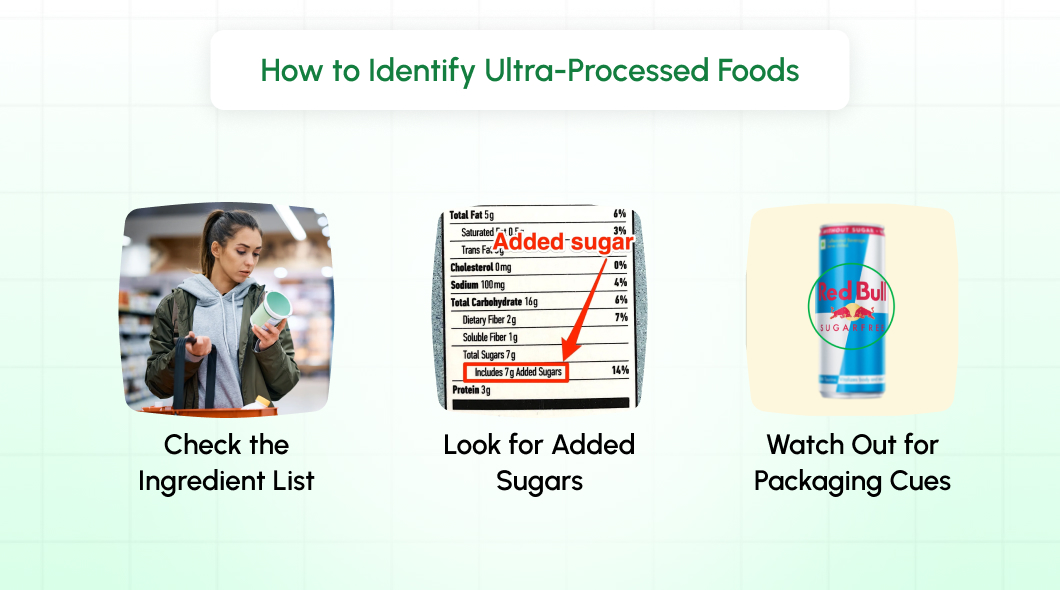
Ultra-processed foods are designed for convenience and taste but are often stripped of their original nutrients during production. They typically contain added sugars, unhealthy fats, artificial flavors, preservatives, and other additives. Here’s how you can easily spot them in your pantry or while grocery shopping:
1. Check the Ingredient List
If a food has a long list of unrecognizable ingredients that sound more like a chemistry experiment than actual food, it’s probably ultra-processed. Ingredients like maltodextrin, hydrogenated oil, artificial flavoring, or monosodium glutamate (MSG) are a clear giveaway. For example, a loaf of whole-grain bread should only include flour, yeast, water, and maybe salt. But if the label lists twenty ingredients, it’s likely heavily processed.
2. Look for Added Sugars
Sugar sneaks into many ultra-processed foods under various names like high-fructose corn syrup, dextrose, or cane syrup. Flavored yogurts, cereals, and even savory snacks can have surprisingly high sugar content, so always check labels for hidden sugars.
3. Watch Out for Packaging Cues
Ultra-processed foods are often packaged in colorful, eye-catching wrappers marketed with claims like low-fat, sugar-free, or great source of protein. These claims can distract from their high levels of artificial additives and lack of real nutrients. Try comparing a bag of chips to a single apple; the former often comes with layers of flashy packaging and buzzwords, while the latter needs none of that.
Simple Swaps to Reduce Ultra-Processed Foods
Now that you know how to spot them, the next step is reducing your intake of ultra-processed foods. The good news? It’s entirely possible to eat more whole, nutritious meals without sacrificing flavor or convenience. Here are some practical swaps to get you started:
1. Replace Sugary Snacks with Whole Foods
Instead of grabbing a candy bar or pack of cookies during that mid-afternoon slump, opt for naturally sweet alternatives like fresh fruits, nuts, or yogurt with no added sugar. For example, swap store-bought granola bars for homemade energy bites made with dates, oats, and peanut butter.
2. Choose Whole Grains Over Processed Carbs
Refined grains in white bread, pastries, and instant noodles are stripped of fiber and valuable nutrients. Replace them with whole-food options like quinoa, brown rice, or oats. Craving toast in the mornings? Reach for whole-grain bread with minimal ingredients rather than processed sandwich bread.
3. Rethink Your Drinks
Beverages often contribute more calories and sugars than we realize. Replace soda with sparkling water and a squeeze of lime, or swap flavored lattes for black coffee with a splash of milk. If you’re used to sugary juices, try infusing water with fruits like berries or oranges for natural flavor.
4. Batch Cook and Prep Whole Foods
One reason people turn to ultra-processed foods is convenience. Beat this by meal prepping wholesome options ahead of time. Cook large batches of grains, roasted vegetables, or proteins like grilled chicken or tofu each week. Having these ready makes quick, healthy meals a breeze.
Conclusion
Ever wondered what’s really inside that food packet you’re about to eat? Is it just processed—or ultra-processed? The difference might be bigger than you think and can affect your health in the long run. But don’t worry about stressing over reading every tiny label and ingredient. Simply download the FactsScan app and get quick, clear insights into what’s inside your food in just a few seconds. Whether it’s extra sugar, artificial additives, or harmful chemicals, FactsScan helps you uncover the truth behind the packaging. By scanning the label before you eat, you can make healthier, smarter choices for your body. Take control of your diet—scan it before you eat it! Eat clean, live well.
Ready to make Healthier Choices?
Download FactsScan now from the Google Play Store and App Store and take charge of your food choices.

Recent Articles

Top Food Ingredients You Should Avoid for Better Gut Health
Your gut microbiome is the foundation of your overall wellness, affecting everything from digestion to immune function. Yet many everyday food ingredients—artificial sweeteners, refined oils, emulsifiers, and preservatives—are slowly damaging this delicate ecosystem. Learn which harmful ingredients to eliminate from your diet and discover healthier alternatives using smart tools to identify nutritious, gut-friendly options that truly support your digestive health and long-term wellbeing.

How to Identify Healthy Snacks Using the FactsScan App
Discover how the FactsScan App helps you make smarter snacking choices by instantly analyzing ingredients, nutrition scores, and additives. Learn how this AI-powered tool identifies truly healthy snacks and guides you toward better food decisions with just one scan.
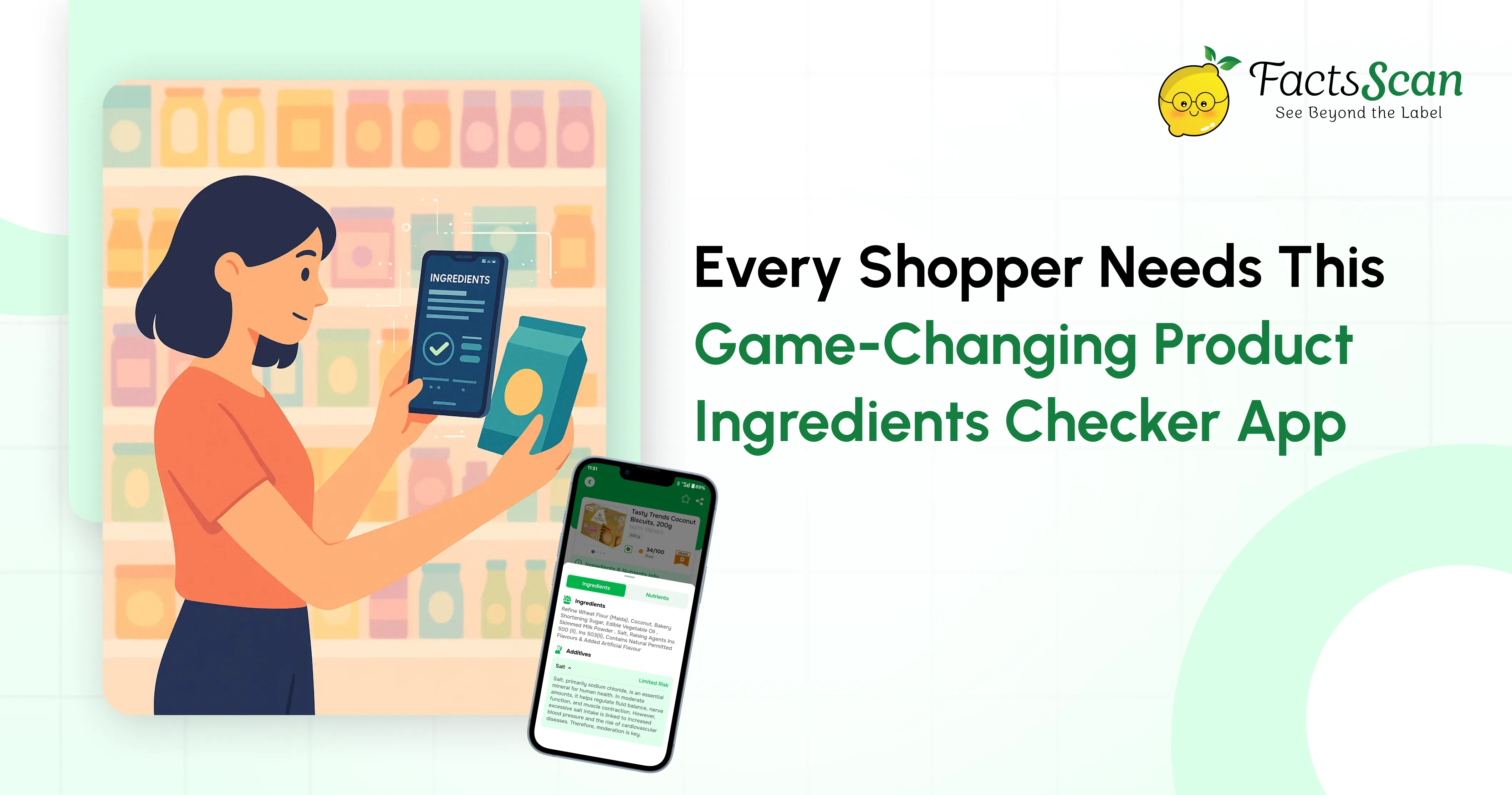
Every Shopper Needs This Game-Changing Product Ingredients Checker App
Tired of confusing food labels and hidden ingredients? This game changing product ingredients checker app helps shoppers instantly scan barcodes to uncover real nutritional facts, health scores, and safer alternatives, making smarter, healthier shopping easier than ever.
 25 Apr 2025
25 Apr 2025 7 Min Read
7 Min Read 
